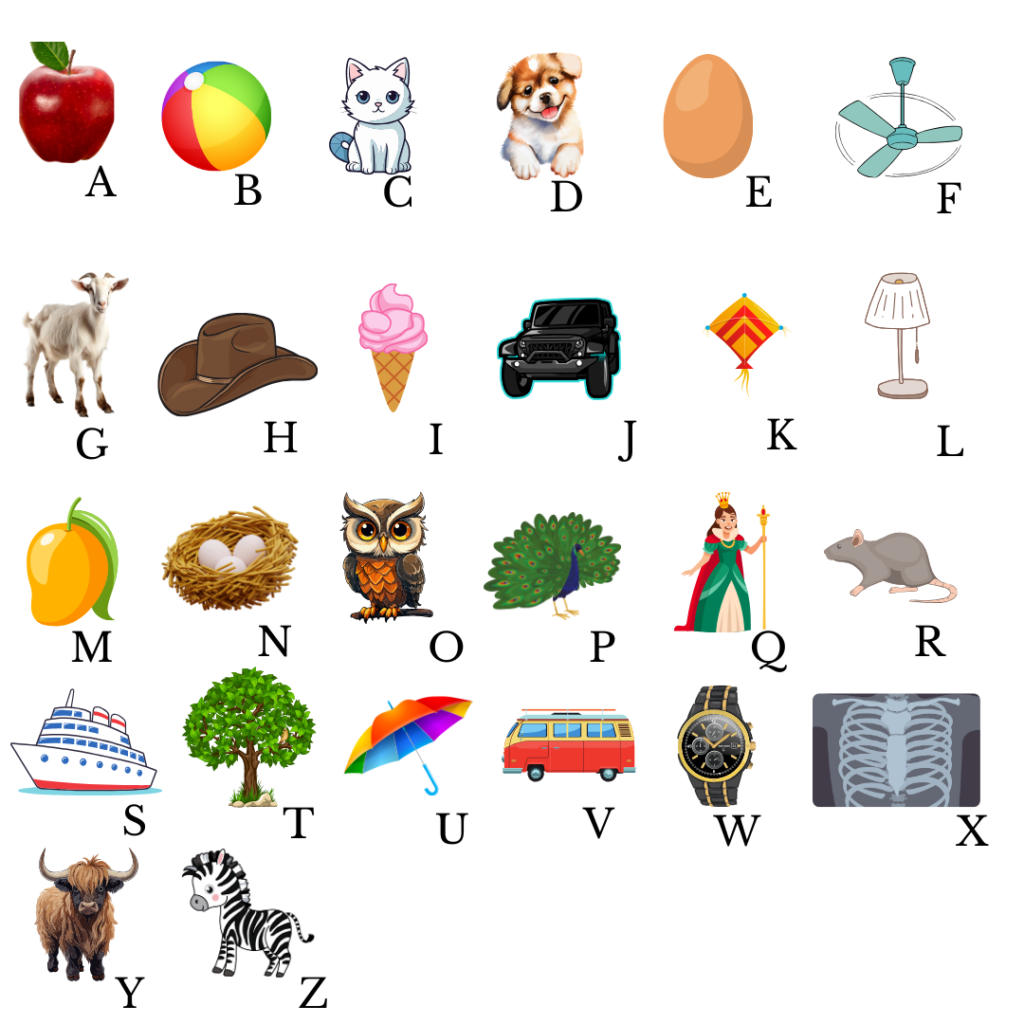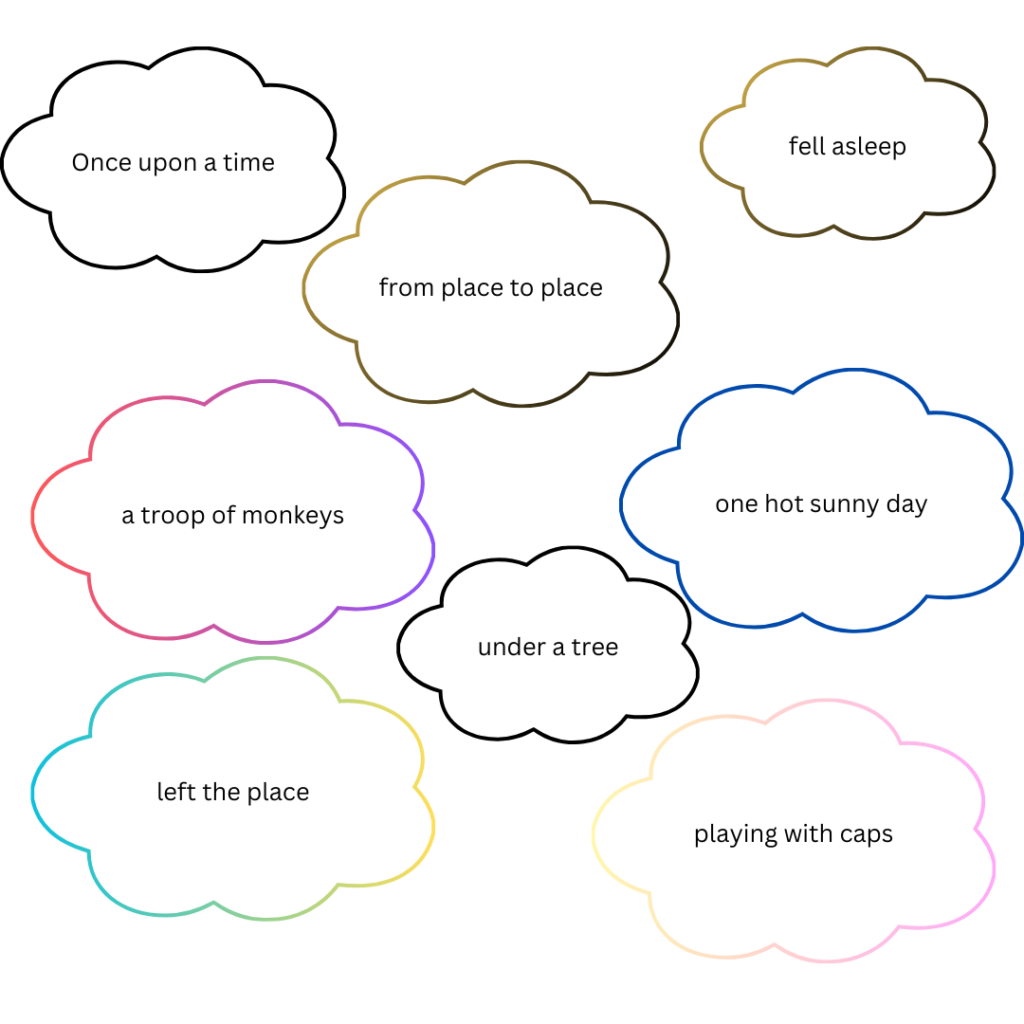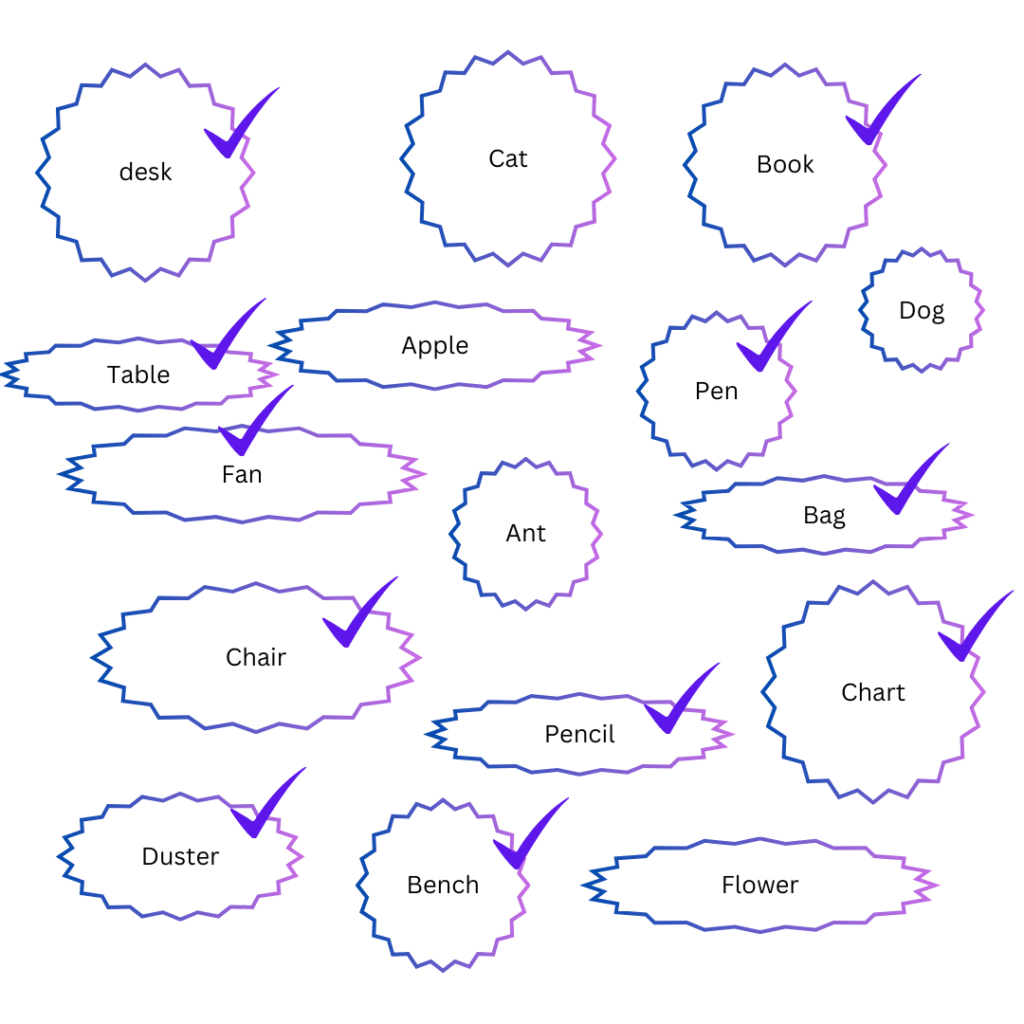Class 2 English Chapter 1 The Toy Man Question Answer, to each chapter is provided in the list so that you can easily browse throughout different chapters SEBA Class 2 English Chapter 1 The Toy Man and select need one.
Class 2 English Chapter 1 The Toy Man
Also, you can read the SCERT book online in these sections Solutions by Expert Teachers as per SCERT (CBSE) Book guidelines. These solutions are part of SCERT All Subject Solutions. Here we have given Assam Board Class 2 English Chapter 1 The Toy Man Solutions for All Subjects, You can practice these here.
(দ্য টয় ম্যান) পুতলা মানুহ
Chapter – 1
ইংৰাজী (ENGLISH)
Let’s recite or Sing
The Toy Man
(দ্য টয় ম্যান) পুতলা মানুহ
Toys! Toys! Toys!
Who’ll buy my toys?
Some for boys
Some for girls
Toys! Toys! Toys!
টয়জ। টয়জ! টয়জ!
হু উইল বাই মাই টয়জ?
ছাম ফ’ৰ বয়জ
ছাম ফ’ৰ গাৰ্লছ
টয়জ! টয়জ! টয়জ!
অসমীয়া অনুবাদ :
পুতলা! পুতলা! পুতলা!
কোনে কিনিব মোৰ পুতলা?
কিছুমান ল’ৰাৰ বাবে
কিছুমান ছোৱালীৰ বাবে
পুতলা! পুতলা! পুতলা!
Activities
1. Let’s talk :
Work in groups and say what you do in your leisure time. Now, look at the pictures and say what the children are doing:
The boy is playing with a car.
The girl is playing with a ball.
A boy and a girl are playing with toys.
Do you like playing with toys? Colour the toy you like and draw your favourite toy:

2. Let’s say and do : (লেটছ ছে এণ্ড ডুঃ) আমি কওঁ আহাঃ
Ma’am: Good morning, children.
Children: Good morning, ma’am.
Ma’am: Please, sit down.
Children:Thank you, ma’am.
3. Complete the bubbles in the picture. You may use words given in the box to say what you learnt so far:
What have you learnt so far?
I have learnt
I have learnt
I have learnt
I have learnt
● to recite and sing.
● to work in pairs.
● to read letters and words.
● number names.
● polite expressions.
● to play roles.
● to write the alphabet.
● the sounds of the letters.
● to draw what I understand.
● to follow instructions.
● to ask questions.
Ans: I have learnt to play an instrument.
I have learnt to sing.
I have learnt the dance moves I like.
I have learnt to play football.
4. Identify the objects in the picture. Say the names: (আইডেন্টিফাই দ্য অৱজেক্টছ ইন দ্য পিকচাৰ। ছে দ্য নেইমছঃ) ছবিৰ বস্তুবোৰ চিনাক্ত কৰা। নামবোৰ কোৱা :

| bat | hat | ball | doll | jug | zebra | shelf |
| shoes | orange | tomatoes | toy | boy | hen | helmet |
| ox | elephant | olive | star | umbrella | yo yo | ice cream |
| monkey | van | floor | tail | palte | trunk | wheel |

| cat | fish | kite | Crow | nest | girl | balloon |
| tree | leaf | jackfruit | hut | dog | bin | table |
| parrot | wall | flower | Sky | Branch | Frock | Water |
| brick | hand | grass | pink | green | Red | White |
5. let’s revise and write letters in the boxes:

6. Write the missing letters. One is done for you:

7. Write the missing letters:

8. Write the missing letters:

Read aloud:
Mohan is a toy man.
He sells toys.
He also sells caps.
Children love him.
Now, complete the following:
Mohan is a —- —-
He sells —-
He also sells —-
Children —- him.
Ans: Mohan is a toy man.
He sells toys.
He also sells caps.
Children love him.
9. Read aloud:
toy boy dry cry
fly by my sky
10. Read aloud the words on the word wall. listen for rhyming words and write them together in groups:
cap map tap
by buy my
took book look
hall fall call
| book fall map buy cap look tap took call |
11. Listen and say:

12. Listen to the story:

The Cap Seller and the Monkeys
Part-I: Once upon a time there was a cap seller. He moved from place to place to sell caps. One hot sunny day he sat down under a tree. He put his basket of caps near the tree. He was very tired and soon fell asleep. A troop of monkeys came to the place. They took away the caps.
Word notes : Once upon a – এসময়ত। A cap seller- টুপী বেচোঁতা। moved- গৈছিল। from place to place- ‘ইঠাইৰ পৰা সিঠাইলৈ। Once upon a- এসময়ত। sell- বিক্ৰী কৰা। hot sunny day- গৰম দিন। under- তলত। put-ৰখা। basket- খৰাহী। near – ওচৰত। tired- ভাগৰুৱা। soon- সোনকালে। fell- পৰিছিল। asleep – টোপনি। troop of monkeys-বান্দৰৰ জাক। took away- লৈ যোৱা।
অসমীয়া ভাবানুবাদঃ এসময়ত এজন টুপী বেচোঁতা আছিল। টুপী বেচিবলৈ তেওঁ ইঠাইৰ পৰা সিঠাইলৈ গৈছিল। এটা গৰমৰ দিনত তেওঁ এজোপা গছৰ তলত বহিল। তেওঁৰ টুপীৰ খৰাহীটো গছৰ ওচৰত থলে। তেওঁৰ বৰ ভাগৰ লাগিল আৰু সোনকালে টোপনি গ’ল। এজাক বান্দৰ সেই ঠাইলৈ আহিল। সিহঁতে টুপীবোৰ লৈ গ’ল।
Part-II: The cap seller woke up after some time. He looked here and there. He saw a few monkeys playing with the caps on the tree. He wanted his caps back. He made a plan. He took off his cap and threw it away. The monkeys also took off their caps and threw them away. His plan worked. He was very happy. He picked up the caps and left the place.
Word notes : woke up- সাৰ পাই উঠিছিল । after- পাছত। some time- কিছু সময়। here and there- অ’ত ত’ত। a few – কেইটামান। wanted- বিচাৰিছিল। back – ওভোতাই। plan-আঁচনি। took off – সোলোকাইছিল। threw- দলিয়াইছিল। worked- কাম কৰিছিল। picked up- বুটলিছিল। left the place- স্থান ত্যাগ কৰিছিল।
অসমীয়া ভাবানুবাদঃ কিছু সময় পাছত টুপী বেচোঁতাজনে সাৰ পাইছিল। তেওঁ ইফালে সিফালে চালে। তেওঁ কেইটামান বান্দৰে টুপীৰে গছৰ ওপৰত খেলি থকা দেখা পালে। তেওঁ টুপীবোৰ ওভোতাই পাবলৈ ইচ্ছা কৰিছিল। তেওঁ এটা পৰিকল্পনা কৰিলে। তেওঁ নিজৰ টুপীটো সোলোকালে আৰু দলিয়াই পেলালে। বান্দৰবোৰেও সিহঁতৰ টুপীবোৰ সোলোকালে আৰু দলিয়াই পেলালে। তেওঁৰ পৰিকল্পনাই কাম কৰিলে। তেওঁ বৰ সুখী হ’ল। তেওঁ টুপীবোৰ বুটলিলে আৰু সেই ঠাইৰ পৰা গুছি গ’ল।
13. Say true or false:
(a) A cap seller sells books.
Ans: False.
(b) The cap seller sat down under a tree .
Ans: True.
(c) A troop of monkeys came to the place.
Ans: True.
(d) He saw a few elephants playing with the caps.
Ans: False.
(e) He picked up the caps and soon fell asleep.
Ans: False.
14. Let’s recite:
Cobbler, cobbler, mend my shoe,
Get it done by half past two;
Stitch it up and stitch it down,
Then I’ll give you half-a-crown.
অসমীয়া ভানুবাদঃ মুচি, মুচি, মোৰ জোতা চিলাই কৰা,
আঢ়ৈ বজাৰ আগতে কৰিবা;
তলে ওপৰে চিলাই কৰিবা,
তেহে মোৰ পৰা আঢ়ৈ ক্রাউন পাবা।
15. Who am I?
Shoes Shoes Shoes
I mend shoes
Come one, come all
Bring your shoes.
Ans: A cobbler.
অসমীয়া ভানুবাদঃ জোতা জোতা জোতা
মই চিলাই কৰো জোতা
সকলোৱে আহা
লৈ তোমালোকৰ জোতা।
16. Let’s read:
(i) A toy man sells toys.
(ii) A book seller sells books.
(iii) An ice cream man sells ice cream.
অর্থ : (i) পুতলা ৱালাই পুতলা বেচে।
(ii) কিতাপ বেচোঁতাই কিতাপ বেচে।
(iii) আইচক্রীম ৱালাই আইচক্রীম বেচে।
17. Let’s say and write :
(a) Who sells toys?
Ans: A toy man sells toys.
(b) Who sells books?
Ans: A bookseller sells books..
(c) Who sells ice cream?
Ans: An ice cream man sells ice cream.
18. Put a tick (√) on the things that you see in your classroom:

19. Look at these shapes. Listen and repeat:

20. Fill in the blanks to complete the name of the shapes. Now, colour the shapes :

21.The word ‘three’ has the letters ‘th’ at the beginning. Listen to the beginning sound in the word ‘three’. Now, listen to words beginning with the letters ‘th’ and repeat:
‘th
thirteen
thirty
thin
thick
things
throw
22. Let’s read these sentences. Complete the sentences by drawing lines. One is done for you:
| Once upon a time | There was a cap seller. |
| He moved from | place to place |
| A troop of monkeys | came to the pace |
| The cap seller | sat under a tree. |
| The cap seller took off his cap | and threw it away |
Now, write the sentences:
(a) Once upon a time there was a cap seller.
(b) He moved from place to place.
(c) A troop of monkeys came to the place.
(d) The cap seller sat under a tree.
(e) The cap seller took off his cap and threw it away.
23. Read the sentences:
What’s this?
It’s a balloon..
What’s that?
That’s balloon
What are those?
Those are clouds.
24. Let’s choose words from the columns A, B, C, D and write sentences. One is done for you:
| A | B | C | D |
| This That | is | a | jugjeepbat |
Put a full stop at the end of the sentences:
This is a jug. This is a jeep. This is a cat.
That is a jug. That is a jeep. That is a tree.
25. Read the words in the frame:
| The a is on cat in mat fat cup table |
Now, make sentences using the words. One is done for you:
(a) The cup is on the table.
(b) The cup is on a mat.
(c) The cat is fat.
(d) The cat is on the table.

Hi! my Name is Parimal Roy. I have completed my Bachelor’s degree in Philosophy (B.A.) from Silapathar General College. Currently, I am working as an HR Manager at Dev Library. It is a website that provides study materials for students from Class 3 to 12, including SCERT and NCERT notes. It also offers resources for BA, B.Com, B.Sc, and Computer Science, along with postgraduate notes. Besides study materials, the website has novels, eBooks, health and finance articles, biographies, quotes, and more.




